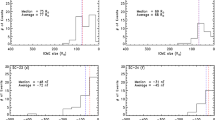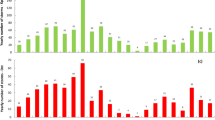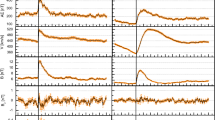Abstract
The characteristics and geoeffectiveness of interplanetary coronal mass ejections (ICMEs) are derived and their relationships are investigated. The results are compared for a set of events in the rising phase of Solar Cycles 23 and 24. These events are considered from the reported list of Cane and Richardson (Geophys. Res. Lett. 27, 3591, 2000). The geoeffectiveness is studied independently for ICME and sheath. The results obtained are that i) CMEs of Cycle 23 have generated a higher Dst index than Cycle 24 CMEs and that ii) the southward magnetic component (\(B_{\mathrm{s}}\)) and the Dst index of ICMEs correlate well for both Cycles 23 and 24 in their rising phase. These findings agree with the literature, which has described Cycle 24 to be weaker than Cycle 23 and where the ICME/sheath regions of Cycle 23 are found to have a greater \(B_{\mathrm{s}}\) that results in stronger storms. In addition, other results obtained are as follows: i) The relation between ICME size and the related Dst index gives a weak correlation for the rising phases of both Cycles 23 and 24. ii) The correlation between sheath size and Dst index is higher in the rising phase of Cycle 24 than in the rising phase of Cycle 23. iii) The average ICME size of the rising phase of Cycle 23 \((84~R_{\odot})\) is greater than that of the rising phase of Cycle 24 \((58~R_{\odot})\). However, the average sheath size is \(24~R_{\odot}\), which is nearly equal to that of Cycle 24 \((26~R_{\odot})\). Thus the differences between the properties of ICME and sheath in both the cycles are demonstrated. Nearly 75 % of geomagnetic storm peaks occurred in the ICME duration in the rising phase of Cycles 23 and 24. This shows that the ICMEs are more important in generating the storms than the sheaths in the rising phase of a solar cycle.





Similar content being viewed by others
References
Brueckner, G.E., Howard, R.A., Koomen, M.J., Korendyke, C.M., Michels, D.J., Moses, J.D., et al.: 1995, Solar Phys. 162, 357. DOI .
Brueckner, G.E., Delaboudiniere, J.-P., Howard, R.A., Paswaters, S.E., St. Cyr, O.C., Schwenn, R., Lamy, P., Simnett, G.M., Thompson, B., Wang, D.: 1998, Geophys. Res. Lett. 25, 3019. DOI .
Cane, H.V., Richardson, I.G.: 2000, Geophys. Res. Lett. 27, 3591. DOI .
Gonzalez, W.D., Echer, E., Clua-Gonzalez, A.L., Tsurutani, B.T.: 2007, Geophys. Res. Lett. 34, L06101. DOI .
Gopalswamy, N.: 2008, J. Atmos. Solar-Terr. Phys. 70, 2078. DOI .
Gopalswamy, N., Akiyama, S., Yashiro, S., Xie, H., Mäkelä, P., Michalek, G.: 2014, Geophys. Res. Lett. 41, 2673. DOI .
Guo, J., Feng, X., Zhang, J., Zuo, P., Xiang, C.: 2010, J. Geophys. Res. 115, A09107. DOI .
Guo, J., Feng, X., Emery, B.A., Zhang, J., Xiang, C., Shen, F., Song, W.: 2011, J. Geophys. Res. 116, A05106. DOI .
Gupta, V., Badruddin: 2009, J. Atmos. Solar-Terr. Phys. 71, 885. DOI .
Ji, E.-Y., Moon, Y.-J., Kim, K.-H., Lee, D.-H.: 2010, J. Geophys. Res. 115, A10232. DOI .
Kilpua, E.K.J., Luhmann, J.G., Jian, L.K., Russell, C.T., Li, Y.: 2014, J. Atmos. Solar-Terr. Phys. 107, 12. DOI .
Kim, R.-S., Moon, Y.-J., Gopalswamy, N., Park, Y.-D., Kim, Y.-H.: 2014, Space Weather 12, 246. DOI .
Lee, J-O., Moon, Y.J., Lee, K-S., Kim, R-S.: 2014, Solar Phys. 289, 2233. DOI .
Lyatsky, W., Tan, A.: 2003, J. Geophys. Res. 108, 1134. DOI .
Manoharan, P.K., Gopalswamy, N., Yashiro, S., Lara, A., Michalek, G., Howard, R.A.: 2004, J. Geophys. Res. 109, A06109. DOI .
Manoharan, P.K.: 2006, Solar Phys. 235, 345. DOI .
Mujiber Rahman, A., Shanmugaraju, A., Umapathy, S., Moon, Y.-J.: 2013, J. Atmos. Solar-Terr. Phys. 105–106, 181. DOI .
Pulkkinen, T.I., Partamies, N., Huttunen, K.E.J., Reeves, G.D., Koskinen, H.E.J.: 2007, Geophys. Res. Lett. 34, L02105. DOI .
Richardson, I.G., Cane, H.V.: 2010, Solar Phys. 264, 189. DOI .
Richardson, I.G., Cane, H.V.: 2011, Space Weather 9, S07005. DOI .
Richardson, I.G.: 2013, J. Space Weather Space Clim. 3, A08. DOI .
Romashets, E., Vandas, M., Poedts, S.: 2008, Ann. Geophys. 26, 3153. DOI .
Shanmugaraju, A., Syed Ibrahim, M., Moon, Y.-J., Mujiber Rahman, A., Umapathy, S.: 2015, Solar Phys. 290, 1417. DOI .
Schwenn, R., Dal Lago, A., Huttunen, E., Gonzalez, W.D.: 2005, Ann. Geophys. 23, 1033. DOI .
Tsurutani, B.T., Gonzales, W.D., Tang, F., Akasofu, S.I., Smith, E.J.: 1988, J. Geophys. Res. 93, 8519. DOI .
Webb, D.F., Crooker, N.U., Plunkett, S.P., St. Cyr, O.C.: 2001, In: Song, P., Singer, H.J., Siscoe, G.L. (eds.) Space Weather. AGU Geophys. Monogr. 125, 123. DOI .
Yermolaev, Y.I., Nikolaeva, N.S., Lodkina, I.G., Yermolaev, Yu.M.: 2010, Ann. Geophys. 28, 2177. DOI .
Yermolaev, Y.I., Nikolaeva, N.S., Lodkina, I.G., Yermolaev, M.Y.: 2012, J. Geophys. Res. 117, A00L07. DOI .
Yue, C., Zong, Q.G.: 2011, J. Geophys. Res. 116, A12201. DOI .
Zhang, J., Richardson, I.G., Webb, D.F., Gopalswamy, N., Huttunen, E., Kasper, J.C., Nitta, N.V., Poomvises, W., Thompson, B.J., Wu, C.-C., Yashiro, S., Zhukov, A.N.: 2007, J. Geophys. Res. 112, A10102. DOI .
Zhang, J., Poomvises, W., Richardson, I.G.: 2008, Geophys. Res. Lett. 35, L02109. DOI .
Acknowledgements
We are grateful to the Solar Geophysical Data, WDC Kyoto, and OMNI team for their open data policy. The CME catalog we have used is generated and maintained by the Center for Solar Physics and Space Weather, The Catholic University of America in cooperation with the Naval Research Laboratory and NASA. SOHO is a project of international cooperation between ESA and NASA. We also thank P.K. Manoharan, head of the Radio Astronomy Center, Ooty for his support. The major research grant No. 42 – 845 / 2013 (SR) to A.S. from University Grants Commission, Govt. of India is kindly acknowledged.
Author information
Authors and Affiliations
Corresponding author
Ethics declarations
Disclosure of Potential Conflicts of Interest
The authors declare that they have no conflicts of interest.
Rights and permissions
About this article
Cite this article
Lawrance, M.B., Shanmugaraju, A., Moon, YJ. et al. Relationships Between Interplanetary Coronal Mass Ejection Characteristics and Geoeffectiveness in the Rising Phase of Solar Cycles 23 and 24. Sol Phys 291, 1547–1560 (2016). https://doi.org/10.1007/s11207-016-0911-4
Received:
Accepted:
Published:
Issue Date:
DOI: https://doi.org/10.1007/s11207-016-0911-4




